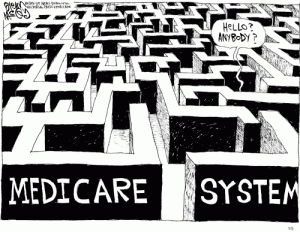By Jack Cumming
On the day of my first video telemedicine visit, I logged in 15 minutes early eager for relief. The week before, I had awakened in the night with a sharp pain in my right knee. When I got up, I could scarcely walk the few steps to the bathroom, the pain was that great. I was happy that I didn’t have to try to get myself to the Kaiser doctor’s office. I don’t know how I would have coped with the pain.
Kinks in the System
As it turned out, despite my early arrival, the doctor was delayed, so I was online waiting half an hour for the visit to begin. That was fine. I was sitting down, which made the pain bearable. Apparently, though, Kaiser has a thirty-minute timeout for its web access, so no sooner did the doctor say, “Can you hear me?” than I was logged out by the system with a message that I’d been inactive too long.
Understandably, there are kinks in the system, which will be worked out as virtual visits become prevalent. Fortunately, the physician waited while I logged back in. Our visit was one of the most positive I’ve had. He suggested that I take Tylenol® and asserted that usually, the pain goes away after two to six weeks. I was glad that I hadn’t had to make my way to his office to hear that. The diagnosis of lumbar radiculopathy was impressive.
My experience has demonstrated how senior living can incorporate initial primary care on campus thanks to the accelerated acceptance of virtual video visits due to COVID-19. Virtual physician visits are not new. The benefits of telemedicine in rural and underserved communities has been discussed for over a decade. But little was done beyond a few pilot programs.
Senior Living Opportunity
Senior living enterprises are uniquely well-prepared to be the beneficiaries of this dramatic change of events. Consider the advantages. Senior living has a concentration of the most medically vulnerable, most medically intensive people in the economy. People over 65 are just 15% of the population but account for 35% of our nation’s cost of healthcare. That disproportion is greater the older the resident population. The potential for reducing costs is vast. Just think of how much can be saved if just half of all emergency room transports can be avoided.
Programs of All-Inclusive Care for the Elderly (PACE) have demonstrated that relationship medicine can save money and improve outcomes. The new recognition of telemedicine by the Centers for Medicare and Medicaid opens an opportunity to bring those benefits widely to senior living to help people of all socioeconomic circumstances, all ages, and all health conditions. When senior living shares in the resulting cost savings, telemedicine can open a new revenue source while providing a distinct advantage unique to congregate living.
With PACE, geriatricians interact regularly with indigent patients who otherwise would require nursing home confinement. That relationship leads to physician insights that allow more responsive care. Telemedicine opens the opportunity to bring these relationship benefits to all who are in a congregate setting.
Senior Living Advantage
The availability of staff in congregate settings makes possible a more complete physician-patient interaction. The physician may want to know the current vital measurements – weight, blood pressure, temperature, and more. On-scene staff can help. The physician may want to examine ears. A video connected otoscope, handled by staff, can make it happen. There is already a range of devices to facilitate remote, video-enabled examinations. The expansion of telehealth will extend the possibilities.
If a senior living community has these remote visit devices available onsite, it can work with many primary care practices to bring medicine to the patients. A special cart equipped with needed devices and supported by trained staff can get relationship medicine off the ground. By encouraging frequent “drop-in” or Q&A visits by physicians to get to know residents where they live, medical outcomes can be improved. The ideal approach has a geriatrician on staff who works seamlessly with residents and who can interact professionally with primary care doctors to address medical issues while maintaining quality of life.
Who Pays for What?
In the past, efforts to use technology to improve the quality of care – such as the refrigerator-sized Ascribe OnSiteRx unit, which reduces medication errors – have not been widely adopted. The OnSiteRx unit contains over a hundred of the most frequently prescribed medications used in senior living. It is fully compliant with requirements for controlled medicines and is remotely managed by the physician and pharmacy.
The OnSiteRx unit is a locked safe maintained by a pharmacy that only dispenses medication units at the direction of a physician confirmed by a pharmacist. It offers many other benefits as well, and it has been available for over a decade. Despite the reduction in litigation exposure, the onsite dispensary is not widely used. Providers argue that the pharmacy should pay for the unit, while the pharmacy sees the unit as primarily benefitting the provider. To optimize the value offered by telemedicine, wise providers will take the lead to replace the doctor’s office as the center for the resident’s medical care team.
Making Senior Living Attractive
Integrating relationship medicine, connecting remotely with primary care or emergency room doctors, into senior living can make congregate living attractive. By allowing on-demand physician oversight of living conditions, telemedicine can also help alleviate concerns raised by the pandemic that senior living is unsafe. Most attractive of all, however, is that relationship medicine can give your community a competitive advantage while improving the resident experience and providing a potential revenue source.
Let’s hope that telemedicine, and the relationship medicine it makes practical, is here to stay.









Mr. Cumming, I was so impressed by your observations that I will share several of your paragraphs with my CCRC management. That sharing will include “management of our management” where that level has national ties and hopefully continuing influence with a trade association.
You should market your crystal balls on EBay.